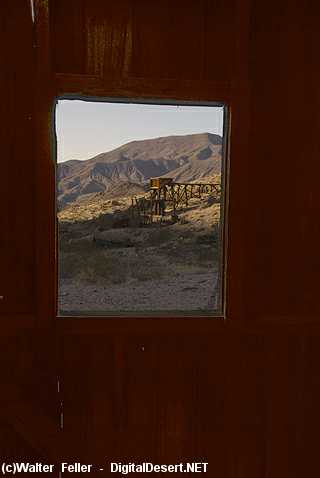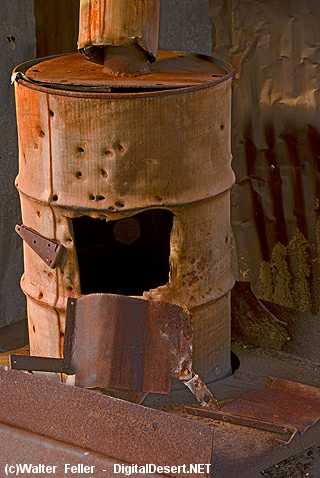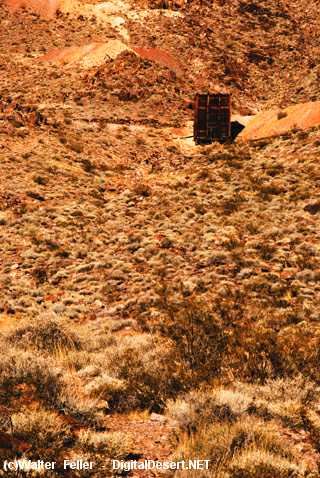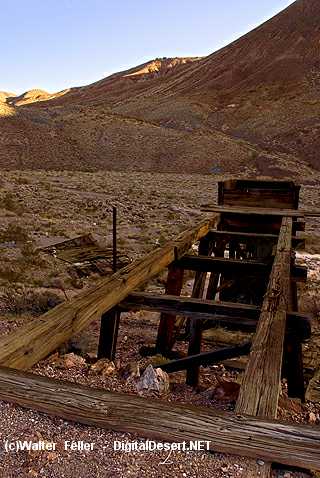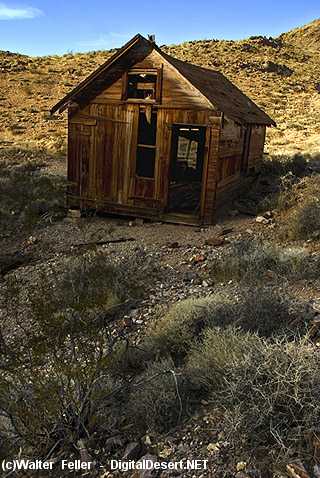Inyo Mine
History
...continuedLike so many of the other Echo-Lee District mines, the Inyo Mine had been fatally crippled by the Panic of 1907. Following the onset of the panic, development work virtually ceased throughout the rest of 1907, and 1908 followed suit. No work was done on the mine during that entire year, and the only notices in the papers concerning it were several rumors of sale. The Bullfrog Miner reported that the mine had been sold to Thomas Lockart, president of the Florence Mine in Goldfield, in March, and the Rhyolite Herald reported that L. Holbrook had secured control of a majority interest in the mine during August. But neither of these rumors were borne out, as the Inyo Mine virtually dropped from sight. In July and August, both papers reported that the mine would be reopened soon, complete with a processing mill, and several paragraphs were taken up in discussions of the possibilities of such an event, but they never occurred. In November, Chet Leavitt promised that the mine would soon be heard from, and stated that all the claims of the company would be patented before the year was out. The company had even taken the opportunity for some nation-wide advertising, when the Weekly Advertiser devoted an issue to Nevada mining, but even the effect of a full-page ad was futile, for the depression upon mining was being felt across the entire nation.
During 1909, the situation did not improve at all. The Rhyolite Herald reported in April that Chet Leavitt had sold his interest in the mine, but a later issue noted that the dear was not definite, and it never was. The company did put some ore on display at the American Mining Congress convention in Goldfield that fair, but little else happened on the property. The company's application for a patent on seventeen of its claims--a total of 215 acres--was approved on August 15th, but like so many other mines of the region which had applied for a patent during the boom days, the papers arrived too late to do the company any good. In September, the Bullfrog Miner optimistically noted that the "Inyo property has arrived at the point where plans for a mill are next in order, and the next week printed a rumor that the Inyo mine "will be subject to the biggest leasing deal yet known in Nevada." Salt Lake City promoters, the paper reported, were negotiating for a long term lease and were planning to develop the ground to the extent of constructing a large size treatment plant. On the basis of this rumor, Inyo Gold stock suddenly appeared on the trading boards, for the first time ever, and was sold at the price of 6¢ per share. But like so many others, this deal also feel through, and the Inyo Mine continued to lay idle.
The rumors continued through the following years, as the Rhyolite Herald reported in January of 1910 that the company was again negotiating for the sale of the property, with the potential buyers proposing the installation of reduction facilities. Again, nothing came of the negotiations, The mine, which had not been worked since the fall of 1907, was not mentioned again until January of 1912, when its stockholders met in Utah with the intention of reducing the par value of the company's stock from $1 to 10¢ per share, apparently as an attempt to start another promotional and development campaign. But again nothing happened, and the Inyo mine was finally abandoned.
Thus ended the first phase of the Inyo mine. Its officers had held onto the mine too long, and had made the decision to go public only after they had run out of private development funds, just in time to see the Panic of 1907 ruin their hopes. After 1907, little if any mining was done to what was once seen--probably correctly--as the best and most promising prospect in Echo Canyon.
But unlike the other mines of the Echo-Lee District, the Inyo Gold had a revival. Unfortunately, that revival took place long after Death Valley mining had lost its appeal, and little notice of the subsequent activities at the Inyo Mine reached the local newspapers. Thus although we know that the mine was operated for several years in the 1930s, we have very little day-to-day knowledge of those operations.
After the death of the mine in 1912, the next known reference to it comes in the fall of 1928, when it was sold to Earl B. Gilbert and Daniel Winzelor. Within a few weeks, Gilbert transferred his half of the mine to his wife. Following those transactions, the mine disappears again until 1937, when Mrs. Gilbert leased it to the Inyo Consolidated Mining Company. In August of that year, the Inyo Independent reported that Guy C. Ridell, a mining engineer from New York, had arrived at the Inyo camp to inspect the mines workings. The mine had apparently been operating for several months at the time of this report, for Loren Granger, the manager, was reported in Bishop, buying another load of supplies for the mine.
In March of 1938, the paper reported that the company was still operating, and had installed a ball mill at the mine, The mill was capable of treating twenty-five tons of ore per day, and water for operations was being hauled from Furnace Creek. Since this was costly and unsatisfactory, the company was planning to build a pipe line and pumping station, if operations at the mine continued on a satisfactory basis. The California Journal of Mines & Geology, in October of the same year, reported that the Inyo Consolidated Mine was working on the seventeen patented and five unpatented claims of the property. The principle development was an inclined shaft, 220 feet deep, and the report listed the lengths and depths of various other shafts, tunnels and crosscuts within the mine. At best estimate, by comparing the figures given to those released by the mine in 1907, the Inyo Consolidated had been working the property for less than two years at the time of this report. Ore from the mine, said the Journal was averaging about $25 per ton, and was being processed through the twenty-five ton capacity ball mill. The mill equipment consisted of a fifty ton ore bin, a six by ten jaw crusher, a thirty ton receiving bin, a reciprocating feeder, a three by six ball mill, amalgamation plates, two Simpson tables, and a drag classifier for dewatering. Water was still being hauled from Death Valley, and eight men were employed at the mine and mill.
But shortly after that report, the Inyo Consolidated ceased operations due to a lack of further funds. Although present tailings at the mill site indicate that a limited amount of ore was treated no production record from this era of the Inyo mine exists. In February of 1939, Mrs. Gilbert again leased the mine, to an unnamed individual, who almost immediately found a rich ore shoot at the bottom of one of the shafts. Before the press coverage of this phenomenom ceased, the lessee had sipped thirty-six tons of ore worth $280 per ton to the smelter, for a gross profit of $10,080, and had hired several miners. But once again, the ore shoot ran out, and the lessee was soon out of business.
But the Inyo died hard. The mine was leased again to two men named Thomsen and Wright in 1940, and they installed a small smelter high on a ridge one-halt mile above the former mill site. There, for a short time, they attempted to smelt some of the high grade ore which they took out of a different portion of the Inyo Mine. Again, no production record is available for this effort, which had ended by 1941. A later mining engineer, who inspected this portion of the property, concluded that the furnace at the little smelter had been fired only once, which indicates that the last two lessees of the Inyo Mine were even less successful than had been their predecessors. This was the last attempt to work the Inyo Mine, although its claims are still privately owned.
< Previous
